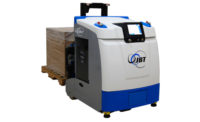As speed and efficiency become increasingly important in warehouse operations, the use of automated guided vehicles (AGVs) and other autonomous vehicles continue to proliferate. The Materials Handling Institute (MHI), Charlotte, N.C., has even recognized this proliferation when it announced that ProMat 2017 will feature the first-ever autonomous vehicle solution center. The 2017 tradeshow will be expanded with exhibits in the South and North Halls, and the North Hall will feature the AGV solution center, the association said.
According to the association, while autonomous vehicle and drone technology still is emerging, 59 percent of respondents of its “2016 MHI Annual Industry Report” said that these technologies are having at least some impact on supply chains. Thirty-seven percent of respondents said that the technology has the potential to provide competitive advantage or to disrupt the industry. Additionally, adoption rates for autonomous vehicle and drone technologies are expected to grow to 50 percent in the next six to 10 years, it added.
“Driverless (or autonomous) vehicles are technologies that are disrupting the traditional supply chains,” said Tom Carbott, MHI senior vice president of exhibitions, in a statement. “In this center, attendees can see, touch and operate these solutions, including automated storage and retrieval systems, automatic guided vehicle systems, driverless trucks, delivery drones and automated crane technologies.”
Industry experts also note the proliferation of AGVs within beverage industry warehouses. “AGVs are becoming more and more common in the beverage industry,” says Mark Longacre, marketing manager of automated systems for Chicago-based JBT Corp. “In general, those who work in the beverage industry are becoming more confident with automation than in prior years. As we begin to enter Industry 4.0, automation and the Internet of Things are the new norm. People no longer fear a robot uprising, and AGVs have benefited from this change in perception.”
He notes that the beverage industry also offers the ideal environment for AGVs. “The uniform sizes of the load, weight and throughput present within the beverage industry makes it an ideal fit for AGVs,” he says. “Beverage applications demonstrate what AGVs really excel at.
“With that said, the industry hasn’t been fully saturated with AGVs just yet,” he continues. “We’re quickly approaching a tipping point. Vehicle capability is rising while costs are dropping. Soon, those in the beverage industry will become very familiar with automated guided vehicles and will see them everywhere.”
Bryan Knott, global product manager of AGVs and flexible automation for Dematic Corp., Grand Rapids, Mich., concurs that the use of AGVs has proliferated within the beverage industry. “With labor rates continuing to escalate and a shrinking of the material handling labor pool, automation continues to grow within the industry,” he says. “While AGVs have been around for many years, the beverage industry is now looking at how they can aid in the labor issues.”
Explaining the growth
Yet, the savings from labor costs is only one among a slew of reasons for the increased use of AGVs in the beverage industry, according to experts.
JBT’s Longacre highlights the ability AGVs have to support tracking as trending and a beneficial component for operators. “Over the past year or so, we have seen an enhanced need to track product and SKUs by automated guided vehicle systems,” he explains. “AGVs support tracking [either] directly using the AGV management software or indirectly through communication with [warehouse management system] (WMS) and (enterprise resource planning) [ERP] systems. … In addition to the numerous end-of-line applications we see each year in the beverage industry, we’re also noticing more and more distribution center opportunities.”
Within the AGV industry, experts have noted several innovations and trends that are driving the growth of AGVs. Dematic’s Knott highlights two main influencers. “Trends are following two unique threads. In conventional AGVs, focus is on navigation technologies and how they can significantly reduce infrastructure needs, which result in lower cost deployments,” he says. “At the same time, there has been an explosion of mini-vehicles — more along the lines of carts or AGCs that have various evolutions of autonomous navigation.”
He says that these mini-vehicles typically follow a predefined virtual guide, like a typical AGV, but utilize advanced navigation technology, allowing them to maneuver around temporary obstacles. “We saw no less than 12 different concepts — all similar in nature — displayed at Modex,” he adds.
Knott also notes a convergence of robotics with mobility. “Exactly what will emerge as a solution and what challenges it will solve in the beverage market are still unknown,” he says.
Additionally, JBT’s Longacre notes that natural environment navigation in AGVs is one of the newest technologies available. “With this type of navigation, sensors enable the AGV to detect things like walls, racking and other fixed plant equipment without the need for additional infrastructure, such as magnetic tape or reflective strips,” he says. “Also, camera-based and laser-based sensors have improved dramatically, making it easier for AGVs to detect pallets, to interface with facility equipment and to perform a greater number of tasks. All of these technologies have combined to make AGV systems more capable.”
Despite the many solutions that AGVs can offer, experts say that these operations aren’t the only benefits. According to Longacre, an increase in safety is easily seen after an AGV system is implemented within a warehouse. “The steady, predictable movement of these vehicles gives plant workers confidence that plant safety is a priority and the facility is often kept cleaner than it might with manual forklifts,” he says.
Dematic’s Knott adds that accuracy is a benefit that AGVs can offer. “Consistent, accurate and safe movement of materials throughout the warehouse at all times [all are benefits],” he says. “They may appear to operate slower than a traditional fork truck, but keep in mind it is a constant state of motion without breaks, calling in sick or taking breaks other than to charge the battery. Because these vehicles are designed to repeat, virtually no product damage occurs. Lastly, when the system is tied to your WMS or ERP, you will have complete visibility and traceability on your goods as they move through the warehouse.”
According to Knott, Dematic offers a varied array of AGVs, including unit-load, lift-top and conveyor decks. “We also offer a broad line of fork trucks with lift heights to 35-plus pounds that replace conventional sit-down, narrow-aisle standup and very-narrow aisle turret-style fork trucks for high-density storage,” he says.
JBT offers a variety of AGV options targeted at the beverage industry, Longacre says. “Our vehicles can automate the movement of empty containers, lids or caps, finished goods and packaging materials like labels, cardboard and empty pallets,” he says. “These movements can fall into several applications, like storage and retrieval at production lines and at the end-of-line.”
Although AGVs seem to have a promising future within the beverage industry, experts note that safety remains a concern. “Safety will always be a concern in the warehouse,” Longacre says.
Dematic’s Knott agrees, and notes the number of accidents involving conventional fork trucks and highlights that AGVs are built to be safe. “AGVs have extensive safety equipment on board — from manual push-button e-stops to more complex and programmable laser-based safety scanners that can look out [more than] 9 feet,” he explains.




